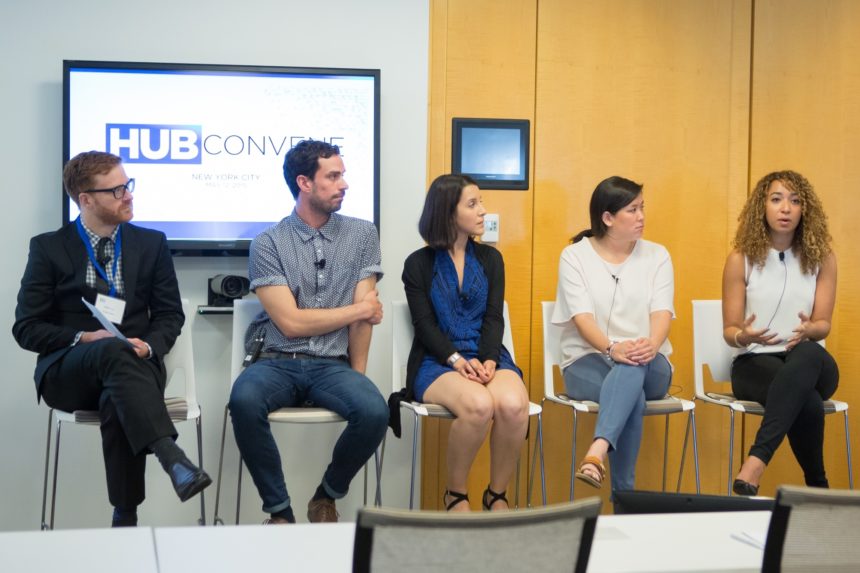It’s OK for consumer marketing to be messy, particularly if the choice is between seizing a unique opportunity to engage audiences or letting the moment pass because a camera angle was not perfectly planned, or the video could look less than professional.
Liz Dennebaum, social-media director of the cable and satellite TV network Epix, said her company made this choice when it decided to use Periscope, a live-streaming video app, to live-stream the premiere of singer Katy Perry’s Katy Perry: The Prismatic World Tour concert film in March.
“It didn’t matter that it wasn’t highly produced because her fans loved it,” Dennebaum told an audience of media professionals at the Hub Convene conference in New York’s Financial District on Tuesday. The Hub is a marketing technology blog owned by Haymarket Media, MM&M‘s parent company.
Dennebaum, who participated in a panel with digital leaders from the Metropolitan Museum of Art and DoSomething.Org, said Periscope—which became widely available the day of the premier—gave her team the freedom to “get amazing shots just following her on the red carpet.”
Although the images were not the high quality Epix would have had with a professional film crew, the ability to give Katy Perry fans an experience they craved worked because it spoke to the consumers with whom Epix wants to connect.
But it was not an effort that took off without support. Epix backed the on-the-fly first-person experience with a #perryscope hashtag and developed a strategy even though the results may look like a free-form effort.
Results included tweets like:
Most amazing livestream ever ? the periscope made me feel like I was there ? @EpixHD #PrismaticOnEPIX
— Aaisa (@aaisarayne) March 27, 2015
As fleeting as a pop moment can feel, panelists said successful social efforts require planning, a connection to the organization’s mission and a willingness to embrace risk.
Taylor Newby, the Metropolitan Museum of Art’s social-media manager, added a fourth component—giving audiences the freedom to embrace a branded concept and make it their own.
The Met did this by creating the hashtag #emptymet and bringing in professional photographers and social-media influencers to roam the museum when no one else was around. Results included short films and great photography as well as photos visitors have taken at the museum and to which they have attached the hashtag #emptymet. This sort of participation also shows that a social-media effort that meshes with an audience’s perspective can create a strong connection because it becomes an ongoing conversation among users and between users and the brand.
Such a treat to attend #EmptyMet today. #ChinaLookingGlass exhibit was stunning. Many thanks @sree! pic.twitter.com/o2RBgMGH5V
— Niketa Patel (@Niketa) May 8, 2015
This works because fans enjoy it and Newby said it matters because “it is in line with the museum’s mission, which is to educate about the arts.” He noted that half of #emptymet’s followers do not live in the US.
While Epix played with the brand’s tonality and the Metropolitan Museum of Art’s outreach played with the personal museum experience concept, social media is also an opportunity to give depth to promises of transparency.
Social activism group DoSomething.Org did just that when it streamed its campaign approval meeting with Periscope and asked viewers for feedback. DoSomething.Org Chief Marketing Officer Naomi Hirabayashi said the effort got positive feedback, made good content and is the type of access and openness that social-media consumers expect.
The panelists noted that engagement and financial return are two different things. While every social interaction may not lead to an immediate financial return, the interactions can be part of a broader force that leads to an impact downstream. Epix’s Dennebaum said the company makes sure its social-media efforts always direct viewers to watch something on its network. The Met’s Newby said his team, which is part of the Met’s digital media group, coordinates with the marketing team if there is a campaign they can support.
As with any sort of outreach, the content has to be right for the media and, like other mediums, it needs to be watched to see what works for the brand and what doesn’t.
They also said that avoiding social media is not a solution.
“If you’re not comfortable with it, you have to get comfortable,” Hirabayashi said. “It’s what people have come to expect.”








